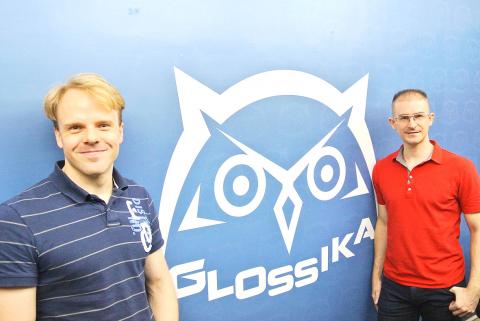Out of his Taipei office, American expatriate Mike Campbell creates downloadable self-study language kits for a global market.
The product, Glossika, is a bit like Rosetta Stone, offering spaced repetition exercises in English, Mandarin, Spanish and other common languages of the world. Unlike Rosetta Stone, Glossika has also begun developing courses for Taiwan’s ethnic and minority languages.
He is planning a kit for Hakka in cooperation with the Hakka Affairs Council (客家委員會), as well as for endangered languages like Amis, Atayal, Puyuma, Rukai, Sediq, Tao, Thao and Truku.

Photo courtesy of Glossika
Released last week, Campbell’s first Taiwan-based course teaches English speakers the language of Hoklo, also known as Taiwanese and one of the Minnan dialects spoken by about 75 percent of the country’s population.
Minnan is a tonal language that branched off from Chinese in the time of Confucius, about a thousand years earlier than Cantonese and Hakka did, Campbell said.
Because it is so old, Minnan retains final palatal endings that today exist elsewhere only in early borrowings of Chinese words in Vietnamese.
Also due to its age, Minnan has a capaciously diverse vocabulary. For example, the Minnan word for beautiful, sui, is cognate with the word suay in the Thai language.
“This language is so old that parts of its vocabulary are Austric or Austronesian. It goes back so far in time when those languages were still developing,” he said.
TAIWAN MINNAN (hoklo)
Minnan was first spoken in what is now Guangzhou and the southeast coast of present-day Fujian province, but today it is also used in Taiwan, Singapore, Malaysia and the Philippines with different intonations that are mutually intelligible.
Campbell’s program teaches Hoklo, a variant of Minnan spoken in Taiwan, featuring voice recordings by Tsan Ik Hian (曾弋軒), a graduate student at Taiwan Normal University’s Department of Taiwan Culture, Languages and Literature (師大台灣語文學系).
“The standard Taiwanese Minnan is different from the version in Fujian due to Japanese colonialization and influences from now-extinct Pingpu Aboriginal tribes. For example, bala (guava) is borrowed from the Aborigines,” Tsan said.
Hoklo also changed during decades of Martial Law era policies that actively phased out its use in favor of Mandarin.
Today, young speakers do not pronounce Hoklo in the standard Taiwanese dialect, but tend to drop the final sounds of syllables, she said.
Tsan, 25, is a native of Greater Tainan who speaks Hoklo in a clear lilting voice.
She is one of the few Hoklo speakers who know and habitually write with tailo (台羅), a romanization system developed by Taiwan’s Ministry of Education in the 1990s.
Hoklo does not have a standard writing system of its own, Campbell said.
Instead, Minnan speakers across history have sometimes used peh-oe-ji, an orthography that missionaries from the West developed in the 19th century.
In Taiwan, some speakers have mastered tailo, but most use Chinese characters idiosyncratically to represent spoken Minnan.
A MORIBUND LANGUAGE
Campbell is developing kits for other languages of Taiwan including Thao, which today has only five living speakers.
The Thao Aboriginal people, who live near Sun Moon Lake, have a dwindling population of around 300. Most are fluent in Mandarin and Minnan but not Thao.
Thao is a 7,000-year-old language with few words for modern technology and a rich and granular vocabulary for plants, animals and other aspects of the physical world.
Two in the tiny cohort of fluent speakers are an elderly couple that Campbell visits in their village for chats. He carefully documents the fine points of lexicon and grammar as his hosts talk and pour tea and the sun sets over their lakeside valley.
“I love the sound. It is very easy to express yourself in this language,” Campbell said.
“It gives you a sort of sense, connection with the earth, nature, history.”
For Campbell, providing minorities access to majority languages can help them substantively improve their lives. Promoting a minority language helps its marginalized speakers survive and be discovered by the world.
“Many of those people are still living here in Taiwan. You just have to find them,” he said.

The Lee (李) family migrated to Taiwan in trickles many decades ago. Born in Myanmar, they are ethnically Chinese and their first language is Yunnanese, from China’s Yunnan Province. Today, they run a cozy little restaurant in Taipei’s student stomping ground, near National Taiwan University (NTU), serving up a daily pre-selected menu that pays homage to their blended Yunnan-Burmese heritage, where lemongrass and curry leaves sit beside century egg and pickled woodear mushrooms. Wu Yun (巫雲) is more akin to a family home that has set up tables and chairs and welcomed strangers to cozy up and share a meal

Dec. 8 to Dec. 14 Chang-Lee Te-ho (張李德和) had her father’s words etched into stone as her personal motto: “Even as a woman, you should master at least one art.” She went on to excel in seven — classical poetry, lyrical poetry, calligraphy, painting, music, chess and embroidery — and was also a respected educator, charity organizer and provincial assemblywoman. Among her many monikers was “Poetry Mother” (詩媽). While her father Lee Chao-yuan’s (李昭元) phrasing reflected the social norms of the 1890s, it was relatively progressive for the time. He personally taught Chang-Lee the Chinese classics until she entered public

Last week writer Wei Lingling (魏玲靈) unloaded a remarkably conventional pro-China column in the Wall Street Journal (“From Bush’s Rebuke to Trump’s Whisper: Navigating a Geopolitical Flashpoint,” Dec 2, 2025). Wei alleged that in a phone call, US President Donald Trump advised Japanese Prime Minister Sanae Takaichi not to provoke the People’s Republic of China (PRC) over Taiwan. Wei’s claim was categorically denied by Japanese government sources. Trump’s call to Takaichi, Wei said, was just like the moment in 2003 when former US president George Bush stood next to former Chinese premier Wen Jia-bao (溫家寶) and criticized former president Chen

President William Lai (賴清德) has proposed a NT$1.25 trillion (US$40 billion) special eight-year budget that intends to bolster Taiwan’s national defense, with a “T-Dome” plan to create “an unassailable Taiwan, safeguarded by innovation and technology” as its centerpiece. This is an interesting test for the Chinese Nationalist Party (KMT), and how they handle it will likely provide some answers as to where the party currently stands. Naturally, the Lai administration and his Democratic Progressive Party (DPP) are for it, as are the Americans. The Chinese Communist Party (CCP) is not. The interests and agendas of those three are clear, but